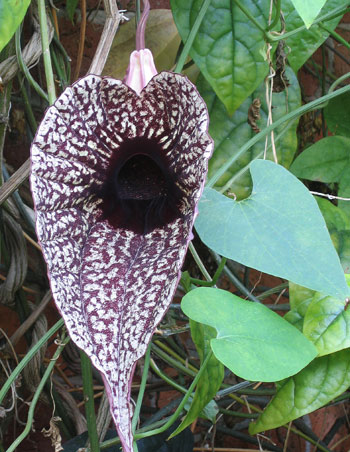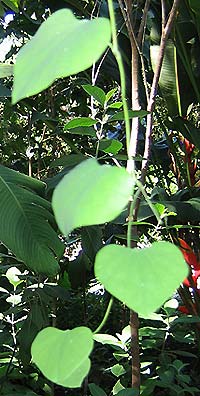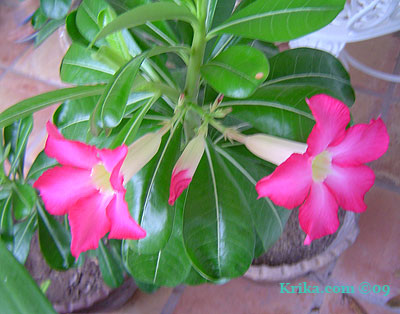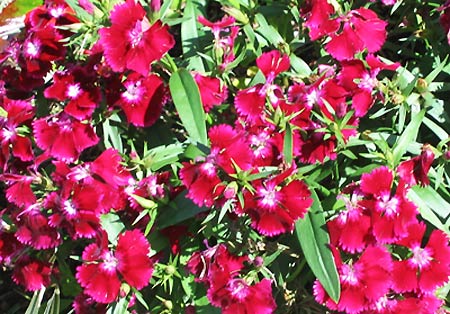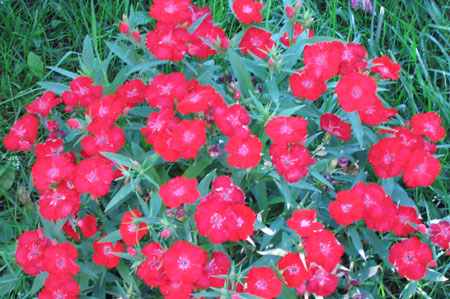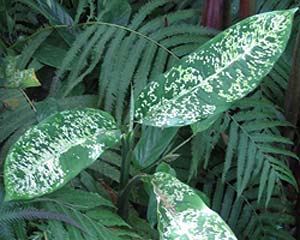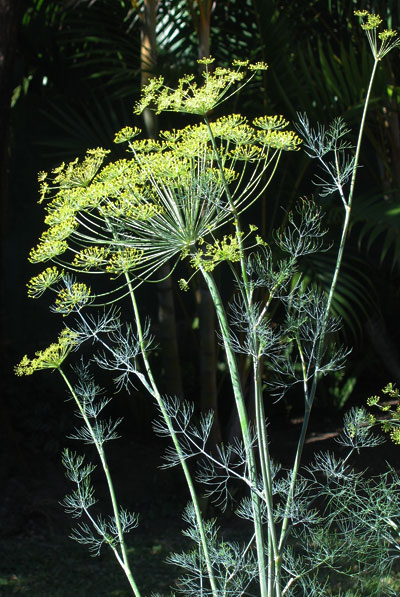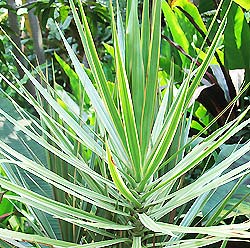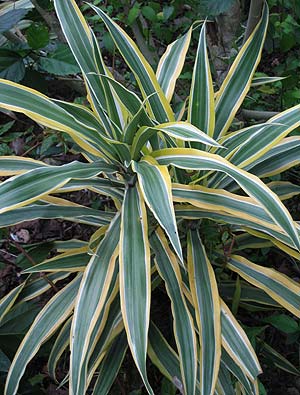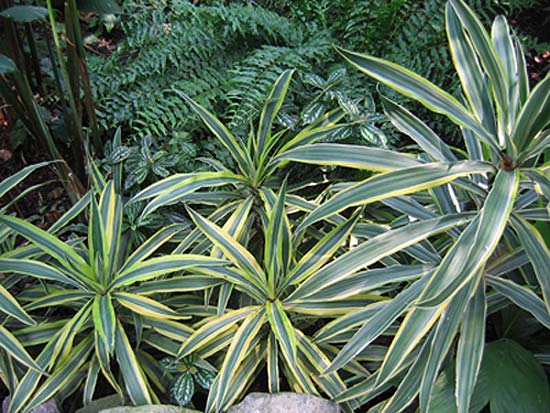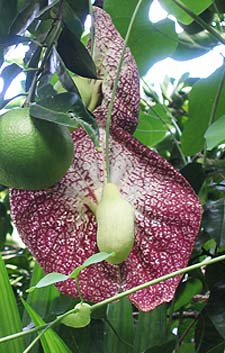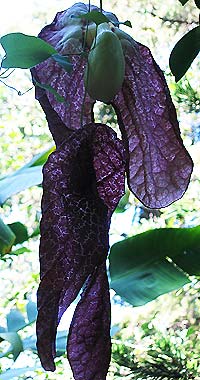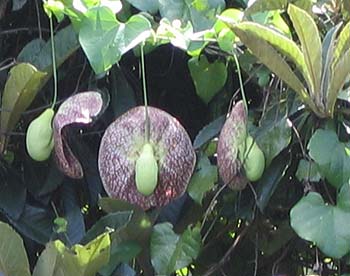|
|
|
|
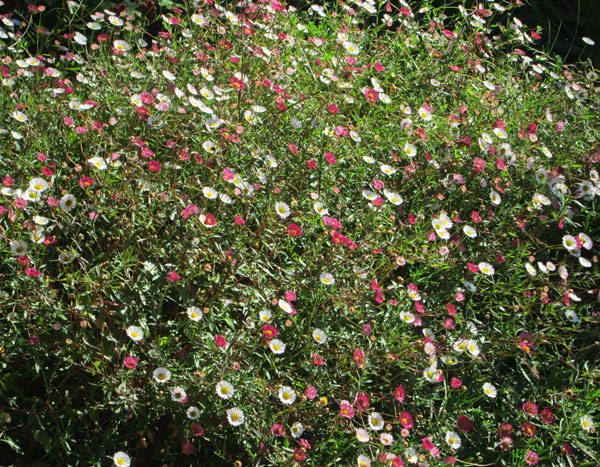 Mexican
Daisy, Erigeron,
Profusion Santa Barbara Daisy, Profusion Fleabane Erigeron
Karvinskianus Profusion Mexican
Daisy, Erigeron,
Profusion Santa Barbara Daisy, Profusion Fleabane Erigeron
Karvinskianus Profusion
This delightful plant has an unending flowering season
where at first small white daisies dominate. In time, as they age,
they begin turning pink to purple as you can see in the photograph
on the left.
Benefits: As a bonus this beautiful plant attracts butterflies
and is resistant to deer. It is also tolerant of heat making it
especially attractive in today's changing climate conditions.
From: Mexico
Photographed: At the Hotel Sonesta in Osorno, Chile, in 2019.
Planting and Care: Once settled into fertile well-drained soil
these
small
perennial
delights have
low water requirements. They make perfect slope bordering flowers.
Text and Photograph ©GreenGardeningCookingCuring.com
2019 |
|
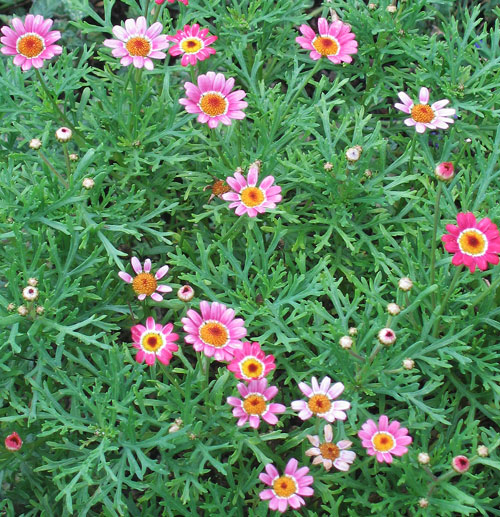 Painted
Daisy Chrysanthemum carinatum Painted
Daisy Chrysanthemum carinatum
These are delightful plants that will bloom all summer giving bright color
to a border garden.
Benefits: Dried Chrysanthemum flowers have been a potent
force in Chinese medicine. So much so that it is recommended as a once daily
tea. Do discuss this with your physician before giving this tea a try.
From: Northern Africa or Asia and northeastern Europe
Photographed: In the Blithewold Garden in Bristol, Rhode
Island, in 2013.
Planting and Care: Grow the annual called painted daisies
in fertile, well-drained, moist but not wet soil in full sun. Probably in
hot climates, it would work better to have them enjoy morning sun, but not
the hot afternoon sun and heat.
Text and Photograph Copyrighted ©GreenGardeningCookingCuring.com
2014/2018
With
my appreciation this plant mystery was solved by Jac from North
Norfolk, England |
Shasta
Daisy Leucanthemum X superbum
Benefits: These easy to care for daisies
will attract bees, birds, and butterflies.
From: The
state of California in the USA.
Photographed: In the Coastal Maine Botanical Gardens, Boothbay,
Maine, 2013.
Planting and Care: These wonderful 2 to 3 foot tall
perennials grow more or less in clumps. They like fertile soil and appreciate
good drainage. They will grow well in bright shade or full sun. Shastas
are considered perennial, but they come back for only a few years
so it is wise to plant some every year to be sure.
Text and Photograph Copyrighted ©GreenGardeningCookingCuring.com
2013/2018 |
|
African
Daisy, South African Daisy, Cape Daisy, Blue-Eyed Daisy Osteospermum
Benefits: This is an easy to care for plant
that will attract birds to your garden.
From: Africa
Photographed: At Ericlea Minoa in
Sicily, Italy, in 2012.
Planting and Care: This is a warm
climate 1 to 3 feet tall annual daisy liking it sunny.
It also likes a rich well draining soil, but does
pretty well in poor soils as well. When well cared
for they will bloom all summer in cooler climates,
but they won't make it through winter.
Text and Photograph Copyrighted ©GreenGardeningCookingCuring.com
2014/2018
With
my appreciation this mystery plant was solved by Jac from North
Norfolk, England |
|
|
 Dalmatian
Chrysanthemum Chrysanthemum cinerariaefolium Dalmatian
Chrysanthemum Chrysanthemum cinerariaefolium
Benefit: The seed cases of this plant are used in extracting pyrethrins
a natural insecticide which is very effective in killing insects and in controlling
mosquitos. Though it is a poison, it decomposes quickly when exposed to direct
sun.
From: The Balkans
Photographed: In the Botanical Garden at the Hotel Atitlan
on Lake Atitlan in Guatemala.
Planting and Care: The Dalmatian chrysanthemum closely resembles
a daisy. It has white flower petals with a yellow center and will grow to as
much as 3 feet in height, though usually less. It has stiff stems and grayish
green foliage.
Text
Copyrighted ©KO 2008 & ©GreenGardeningCookingCuring.com
2018
Please see
other natural pesticides on the "P" Page |
Dandelions Taraxacum
californicum
These are the pretty, but dreaded, lawn weeds that are an excuse for using terribly
toxic weed killers. On the plus side, the entire plant is edible and packs powerful
health improving benefits. Try it in salads or cooked with other greens.
Benefits: In more earth friendly places, dandelions are used
as medicinal
plants to lower blood pressure and to improve the look of your skin.
From: Europe and Asia
Photographed: I haven't yet taken one, but I'll try this summer.
Planting and Care: Look around your neighborhood. When you see
one of those lovely balls of seeds on a stem. Pick one and blow it where you
would most like to see
these delightful yellow flowering weeds. Water your grass normally and soon you'll
have a fine crop of dandelions.
Text Copyrighted ©GreenGardeningCookingCuring.com
2014/2018
|
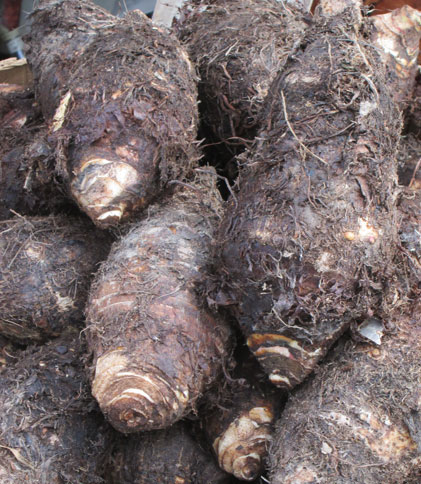 Dasheen,
Taro Colocasia
esculenta Dasheen,
Taro Colocasia
esculenta
Loving water and growing well in full sun or semi shade, dasheen
leaves are related to the elephant ear, but is tougher in dealing
with the
Caribbean sun. It is the above ground edible part of the plant.
Below ground is an edible corm called taro.
Benefits: Both the corm and leaves have
nutritional value. The corm provides a smooth nutty and sweet
food that babies like very much while the leaves
provide protein and vitamins A and C.
From: India and South East Asia
Photographed: In
the market in Scarborough, Tobago, in 2018.
Planting and Care: This plant does well in fertile deep marshy
soil and will even grow with its base in flowing water. It lives best in full
sun with frequent rainfall to maintain proper soil conditions and humidity in
the air. Uncooked this plant is toxic, but it is rendered
safe
with adequate cooking.
Text
Copyrighted ©KO 2007, ©GreenGardeningCookingCuring.com
2018
|
David
Verity Cigar Plant Cuphea x 'David Verity'
Benefits: This terribly named plant is a
hummingbird and butterfly attractant.
From: The David
Verity Cigar Plant is a hybrid
Planting and Care: Give this sweet little perennial
plant full or partial sun and routine rainfall or watering and
you'll have its pretty flowers to enjoy for months each year.
The best part is the plant itself takes care of expiring flowers
so you don't have to remove them yourself. When mature it will
reach a height of 1.5 to 2.5 feet and it will spread about the
same amount.
Text
and Photograph Copyrighted ©KO 2010 |
Photographed: In
the Botanical Garden at the Hotel Atitlan on Lake Atitlan
in Guatemala.
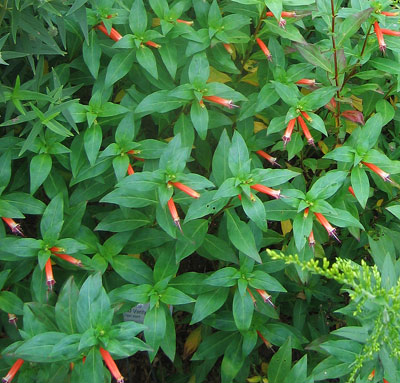
|
Photographed: In
the Blithewold Garden in Bristol, Rhode Island 2013.
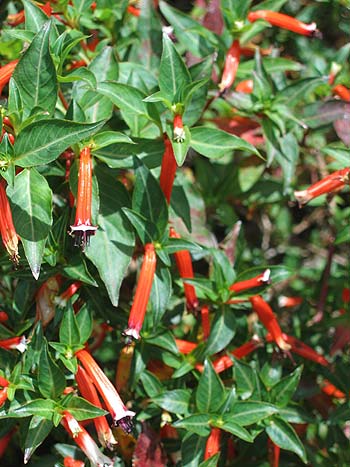
|
|
|
|
Photographed: In
our garden at Lake Atitlan in Guatemala. This
photograph was an accident and I am ever grateful when I
make these "mistakes."
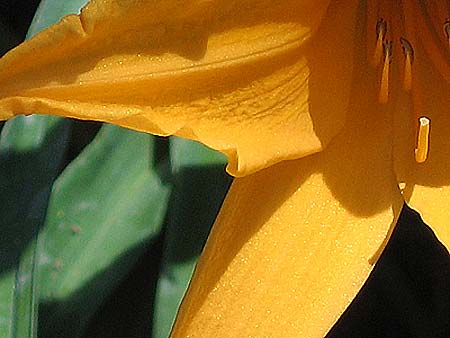
|
Daylily,
Daylilies Hemerocallis
This
large family of wonderful flowering perennials prefers a
little shade from the hot mid-day sun in warm climate places.
Up north all day sunshine is fine.
Benefits: Apparently
all parts of the plant are edible, though the flower is most
likely to find itself in the cook pot.
From: The Pacific
Planting
and Care: In most places, full sun and routine rainfall
or watering will keep these plants thriving and in bloom.
Once
well established,
they are even a bit tolerant of drought and high heat although
it will probably lessen the number of blooms on each plant.
Text and Photographs
Copyrighted ©KO 2010 and ©GreenGardeningCookingCuring.com
2014/2018
"Daylily
is the common name for blooming plants which belong to the
genus Hemerocallis. The flowers of the plant are diverse
in color and form, due to continuous efforts by gardening enthusiasts
and horticulturalists to create new hybridized forms."
Contributed by Sharon from Denver, Colorado.
Many thanks, Kathleen |
|
| |
Daylily
'August Flame' Hemerocallis
Photographed: In the Thuya Garden,
Mt. Desert Island, Maine, 2013.
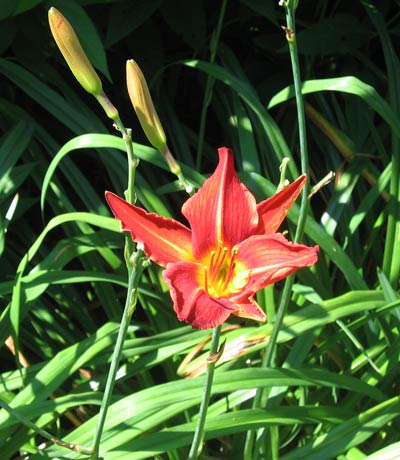
|
Daylily
'Green Eyes Wink' Hemerocallis
Photographed: In the Thuya Garden, Mt. Desert Island, Maine,
2013.
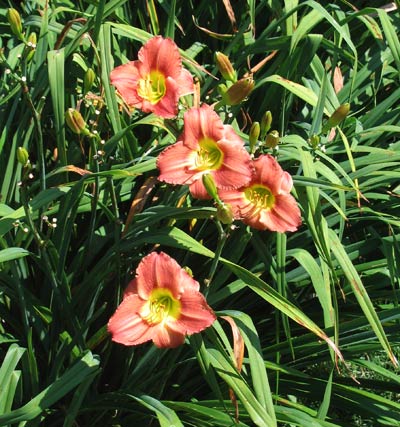
|
|
Daylily
'Joan Senior' Hemerocallis
Photographed: In
the Coastal Maine Botanical Gardens, Boothbay, Maine, 2013.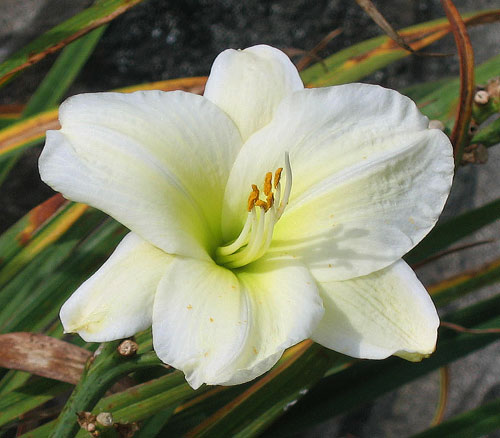
|
Daylily
'Strawberry Candy' Hemerocallis
Photographed: In
the Coastal Maine Botanical Gardens, Boothbay, Maine,
2013.
|
Daylily
'Confectioner's Dream' Hemerocallis
Photographed: In the Thuya Garden, Mt. Desert Island, Maine, 2013.
With my appreciation, this daylily was identified
by a new visitor to the site, Sharon from Denver, Colorado.
Many thanks, Kathleen
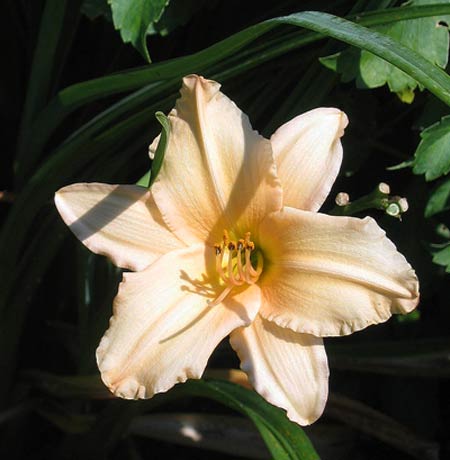
|
Orange
Daylily Hemerocallis fulva
Photographed: In the Hotel Regis garden at Lake Atitlan in Guatemala,
2012.
With my appreciation, this daylily was identified
by a new visitor to the site, Sharon from Denver, Colorado.
Many thanks, Kathleen
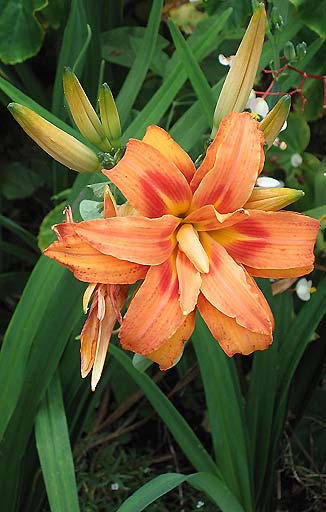
|
|
Orange
Daylily Hemerocallis fulva
Photographed: In
our garden at Lake Atitlan in Guatemala.
With
my appreciation, this daylily was identified by a new visitor to the site, Sharon
from Denver, Colorado.
Many thanks,
Kathleen

|
Jersey
Spider Daylily
Photographed: In
the Hotel Regis garden at Lake Atitlan in Guatemala, 2012.
With my appreciation, this daylily was identified
by a new visitor to the site, Sharon from Denver, Colorado.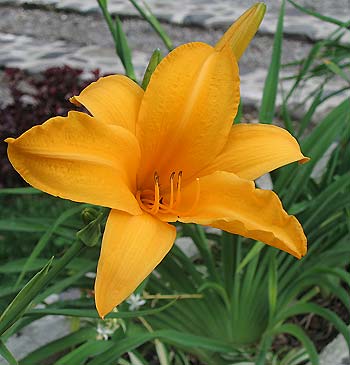 |
Orange
Daylily Hemerocallis fulva
Photographed: In
our garden at Lake Atitlan in Guatemala.
With my appreciation, this daylily was identified by a new visitor to the site,
Sharon from Denver, Colorado.
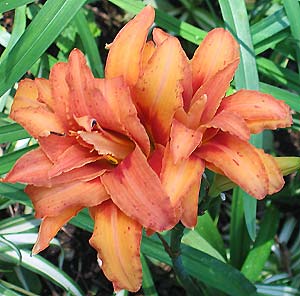
|
|
Red
Rum Daylily Hemerocallis
Photographed: In
the Hotel Regis garden at Lake Atitlan in Guatemala,
2012.
With
my appreciation, this daylily was identified
by a new visitor to the site, Sharon from Denver,
Colorado.
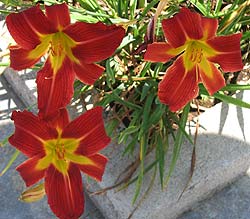 |
Yellow
Daylily Hemerocallis
Photographed: Coastal
Maine Botanical Gardens, Boothbay Maine,
2013.
With
my appreciation, this daylily was identified by a new visitor to the site, Sharon
from Denver, Colorado.
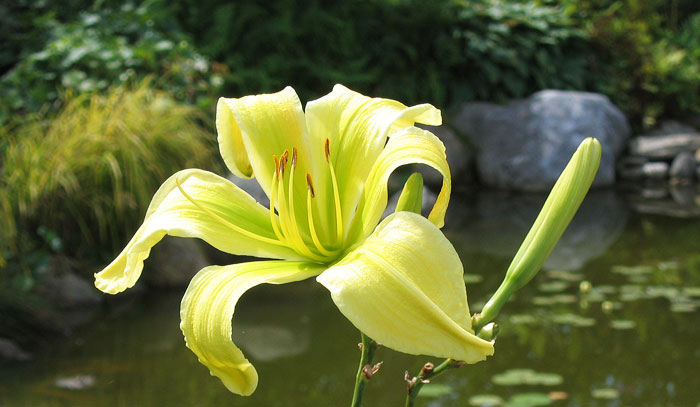
|
Radiation
Biohazard Daylily Hemerocallis
Photographed: In
the Hotel Regis garden at Lake Atitlan in Guatemala, 2012.
With
my appreciation, this daylily was identified by a new visitor
to the site, Sharon
from Denver, Colorado.

|
Ice
Carnival Daylily Hemerocallis
Photographed: At the Hotel Atitlan on Lake Atitlan in Guatemala.
With
my appreciation, this daylily was identified by a new visitor
to the site, Sharon
from Denver, Colorado.
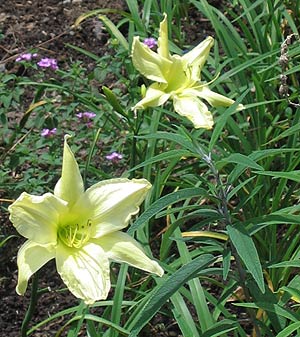
|
|
| |
White
Daylily Hemerocallis
fulva
Photographed: In
Bar Harbor, Maine, in the summer of 2013.
With
my appreciation, this daylily was identified by a new visitor to
the site, Sharon
from Denver, Colorado.
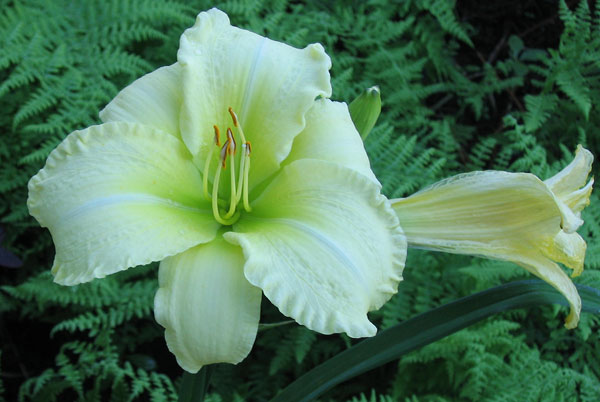
|
White
Daylily Hemerocallis fulva
Photographed: In
Bar Harbor, Maine, in the summer of 2013.
With
my appreciation, this daylily was identified by a new visitor to
the site, Sharon
from Denver, Colorado.
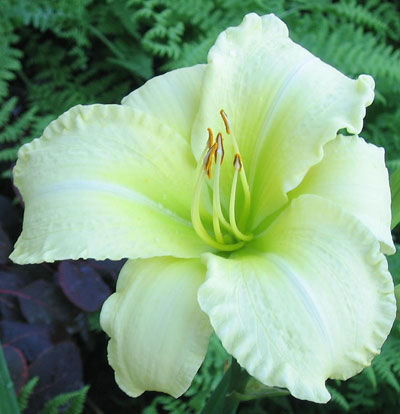
|
|
Yellow
Daylilies
Photographed: At
the Roger Williams Park Botanical Center in Rhode Island in 2013.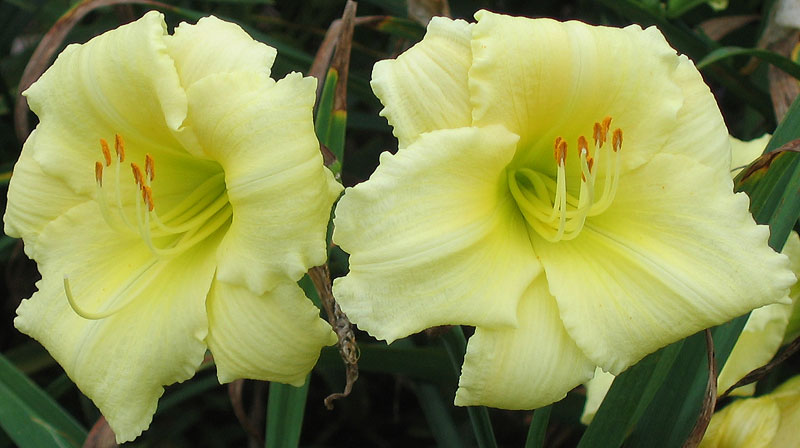
|
|
| Desert
Cabbage See
The "K" Page Kalanchoe |
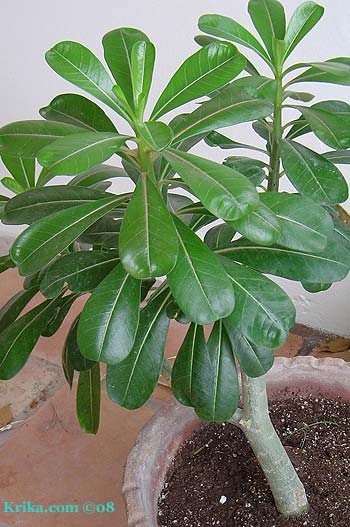
|
**Desert
Rose, Adenium Adenium
obesum
In appearance the desert rose seems to be a member of the
frangipani family.
Benefits: It is said by some to have medicinal
benefits though I have not found specific directions on how it
should be
used.
From: The Middle East
Photographed: On the tiled entryway to our former
home in Montserrat and below in our deck garden.
Planting and Care: Plant it in the sun and keep
this plant relatively dry or the results will be very disappointing.
When well cared for it will grow to be about five feet tall with
its branches spreading to be about four feet wide.
Warning: This plant is poisonous
and its sap was actually used in hunting game in Africa.
Photographs
©Krika.com 2007/2009 and text ©GreenGardeningCookingCuring.com
2018 |
|
|
|
**Devil's
Ivy See
The "P" Page POTHOS
|
|
|
|
**Devil's
Twine See The
"L" Page LOVE VINE
|
| **Dhal See
the "P" Page -- PIGEON PEA |
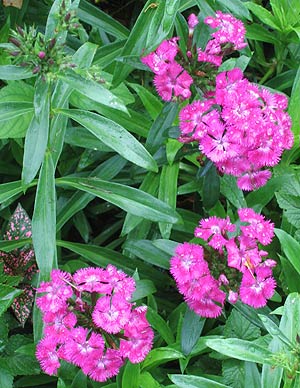 **Dianthus,
Pinks, Carnations, Sweet William Dianthus **Dianthus,
Pinks, Carnations, Sweet William Dianthus
To me, these have always been tiny carnations. They were in
my garden as a young child and each year I looked forward
with joy when they began blooming. I
think
we called them "pinks" at the time.
Benefits: Dianthus are said to have many curative qualities.
From: From Europe and Asia generally but there are also family members
native to north Africa.
Photographed: In Ushuaia, Patagonia, Argentina, in the Botanical
Garden at the Hotel Atitlan on Lake Atitlan in Guatemala and at the bottom in
the Thuya Garden on Mt. Desert Island, Maine 2013.
Planting and Care: These are extremely easy to grow perennials.
Get little plants at your local garden shop in the spring. Pick a place in the
sun in your garden if you are in a northern climate and one with mid-day shade
if you are in a hot climate and set them in. Give them routine watering or rainfall
to keep them happy.
Text and Photograph Copyrighted ©GreenGardeningCookingCuring.com
2013
Flower
Mysteries solved by my friend Ursula G. living in Southern
Germany
|
| |
|
| |
Dianthus 'Lavender
Elegance'
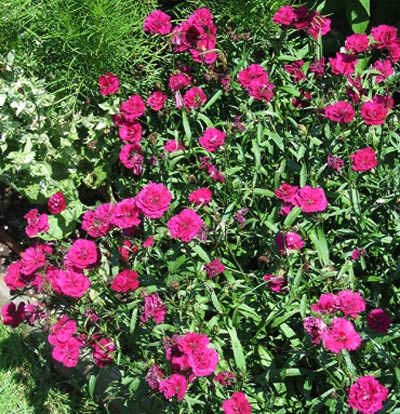
|
Dianthus 'Lavender
Elegance'
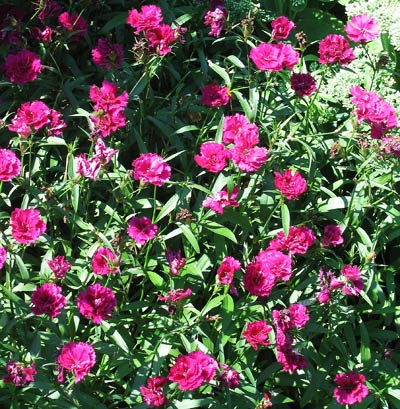
|
|
**Dieffenbachia,
Dumb Cane Dieffenbachia seguine (Jacq.)
This is another one of the many poisonous plants common in the Caribbean. We
have three of them growing in our shady terraced garden.
Benefits: None that I have found so far.
From: Tropical America
Photographed: On the left in our terrace garden at our former
home in Montserrat and on the right in the Botanical Garden at the Hotel Atitlan
in Guatemala.
Planting and Care: Dieffenbachias are popular house
plants in northern climates especially in public buildings as they
tolerate low light very well and require little care.
Planted in a tropical setting keep them out of the mid day sun. They
will do best in a bright shady area where they will receive routine
rainfall or watering. I should say it was a treat to have former
house plants growing happily outside in my garden.
Warning: Dieffenbachia is poisonous to humans and
animals if ingested.
Text
and Photographs ©KO 2008/2010 and ©GreenGardeiningCookingCuring.com
2018 |
|
| Digitalis
-- See Foxglove on the F page |
**Dill Anethum
graveolens
Dill is an annual herb, a member of the carrot family, which needs
to be refreshed in the garden more than many of our old standbys. Fresh
dill
is used
in
making
dill
and kosher dill pickles and in flavoring salads
and
more.
Walk
through
your garden
brushing
your
dill plants with your hand as you pass and simply refresh yourself
with the aroma.
Benefits: Dill is said to be helpful in reducing
your heart rate and I have personally found this to be true. Talk
with your
physician before depending on dill to help you. Don't count on
the dill in pickles to help because salt used in the pickling
process will undue the help. Use dill as a flavoring in other foods
as in the
recipe
below.
From: The Mediterranean region
and southern Russia.
Photographed: In our latest garden at
Lake Atitlan in Guatemala.
Planting
and Care: Dill
does not transplant well so seeds should be planted where the plants
will
grow. They
will
eventually be about three feet tall or more so keep that in mind
when selecting a place to plant them. Dill prefers to grow in a
place with full sun and a well drained ordinary soil.
Text and Photographs ©GreenGardeningCookingCuring.com
2013/2018 |
|
| |
RECIPE:
Baked
Fish with Dill and Onions 2 8
oz each thick deep ocean fish fillets
7 or 8 large freshly cut till plant tops (about 8" long)
1 very large white
onion sliced thin
2 to 3 Tablespoons very fresh salted butter
1/2
tsp. freshly ground black pepper or to taste
Heat
the oven to 350° F. while you butter the glass
casserole, arrange the fish and dill, slice and arrange the
onion, grate the pepper over the onions and slice the remaining
butter on top. Cover with a glass dish or the shiny side
of aluminum foil and bake for just under 1 hour.
|
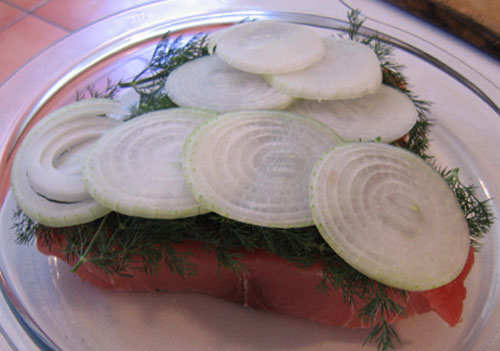 |
|
|
| **Dinner
Plate Aralia See
The "A" Page ARALIA |
|
DISEASES
AND DEFICIENCIES
These
two plant disorders, diseases and deficiencies, seem to me to
be the most serious problems in a tropical garden environment
and
to
the
novice they
are usually
difficult to distinguish. If you are in an area close by a governmental
or university agriculture department, make use of their expertise.
If you encounter a problem in your garden that you do not understand
or cannot identify and treat, call them right away for a consultation.
What
follows is information on the plant diseases and deficiencies
we have encountered in our gardens and the solutions that seemed
to work. It is far from a complete list of the problems you may
encounter, but we hope you will find the information useful.
Deficiencies
Chlorosis
-- Leaves appear to have splotchy yellowing, that
does not follow the leaf veins. This is an indication that
the plant is missing one of the minor, but still essential
ingredients for
its health, probably a mineral. We've had good luck solving
this problem by quickly using Miracle Grow in a watered down
solution daily for a week or so, but it really is an indication
that the soil is inadequate. Using
compost
and
composted
manure is a more long term and healthful solution.
Diseases
Damping
Off -- Almost all gardeners are familiar with this.
You plant your seeds in little pots and not long after the
tiny green shoots appear, they fall over dead. That
is a scenario I experienced in New England. In the Caribbean,
our seventy foot long, twelve foot tall hibiscus hedge fell
over dead. That puts things quickly in perspective.
Powdery
Mildew -- This is what you're seeing when the usually
hairy leaves of your plants especially squash & cucumbers take
on a talcum powder look while the leaves become very papery before
turning yellow and dying. It spreads quickly, but if you catch
it quickly you'll do just fine.
Treatment
First
remove any infected leaves and place them in a closeable plastic
bag for disposal. They must not go into your compost pile. Mix
1 cup of milk with 1 gallon of water and spray each and every
leaf
and
plant that has shown the disease. Keep a close eye on the progress
plants make in recovery. If it doesn't look good, pull up and dispose
of the entire plant.
We
invested in a small garden sprayer that carries about 2 gallons.
It isn't too heavy, but it also holds enough of the treatment all
at once to make the whole operation pretty efficient. My poor husband
shouldered this sprayer in Montserrat for various reasons. Neighbors
told us later they thought we were spraying insecticide, but
we never, ever used anything but simple household liquids like
milk & soap.
|
|
| Dishcloth
Gourd See
The "L" Page -- LOOFAH |
| Dombea
See the "T" Page -- TROPICAL HYDRANGEA |
| Donkey's
Ears See the "K"
Page -- KALANCHOE -- Donkey's Ears |
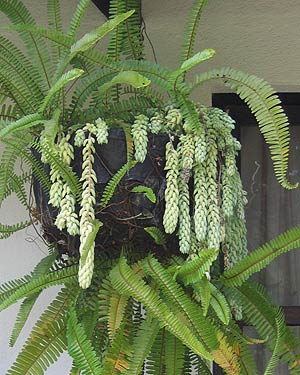
|
**Donkey's
Tail, Burro's Tail Sedum morganianum
This easy to care for plant is almost
a "must have" in Mexico and Guatemala. I absolutely
love them. This year I got a great surprise,
a blossom.
Benefits: They
are said to relieve coughs, but I have no idea what
part of the plant is used or how it is prepared and
administered. It's probably best to talk with your
doctor before using any herbal treatment.
From: Southern Mexico
Photographed: At the Hotel San Buenaventura
on Lake Atitlan in Guatemala in May 2010.
Planting and Care: They are said to prefer
full sun, but I have very often seen them growing beautifully
in semi shade. Go light
on the water to keep them happy and avoid hanging them in strong winds.
Text and Photographs ©KO 2010
& GreenGardeningCookingCuring.com 2015/2018. |
Photographed: At
the Hotel San Buenaventura on Lake Atitlan in Guatemala in
May 2010.

|
|
| |
Photographed: In our garden at our home by Lake Atitlan in Guatemala in 2015.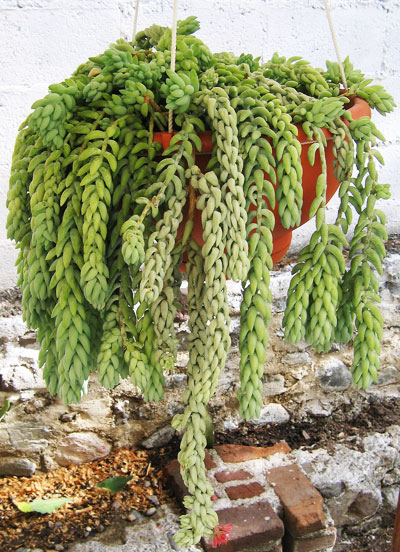
|
Photographed: In
our garden at our home by Lake Atitlan in Guatemala in
2015.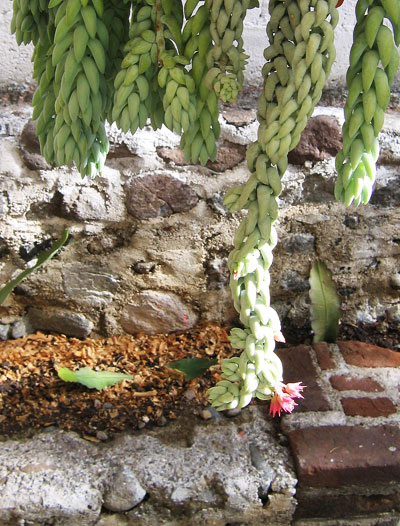
|
|
| |
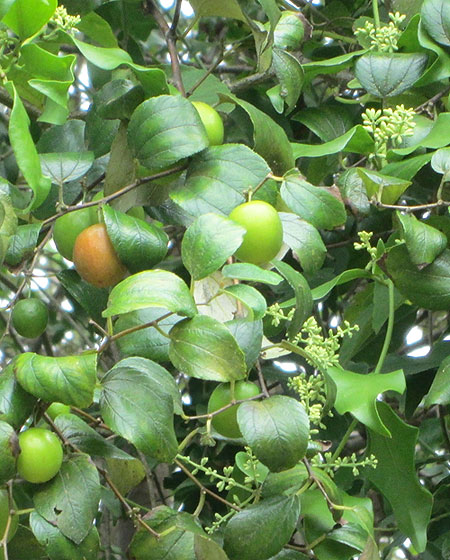 Doung
Tree, Chinese Date, Jujube, Indian Plum Ziziphus mauritonia jujube Doung
Tree, Chinese Date, Jujube, Indian Plum Ziziphus mauritonia jujube
The doung tree grows either like a large bush or a small
tree reaching about 40 feet at its highest. Those near us in Tobago
are trees bearing a popular fruit I would say is much like a large
plump
olive.
Benefits: The fruit is plentiful and edible,
though best when young. Doung fruits take on a fairly unpleasant taste
as
they age.
From: Southeast Asia
Photographed: In Crown Point, Tobago, in 2018.
Planting and Care: This is a very tolerant tree growing quickly
in either dry or wet conditions. Though it is said to prefer well draining alkaline
soils, it will also do well in neutral ground. Oddly enough it does not appreciate
higher
altitudes, liking it below about 3000 feet. It is not a tree I would recommend
for the home gardener because of its tendency to unpleasant tasting fruit.
Text and Photograph ©GreenGardeningCookingCuring.com
2018 |
|
|
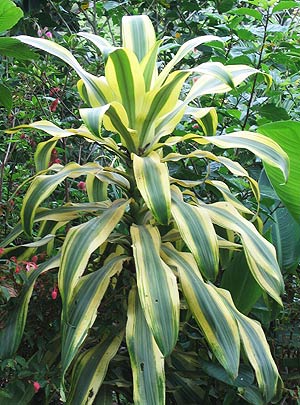 Corn
plant Dracaena
fragrans Corn
plant Dracaena
fragrans
Benefits: This is one of the common household
plants that is said to help in clearing indoor air of pollutants
like formaldehyde, xylene, and toluene.
From: Tropical African highlands
Photographed: At
the Hotel San Buenaventura on Lake Atitlan in Guatemala in
2010.
Planting and Care: The corn plant is tolerant of light level situations,
but prefers a semi shady spot with routine rainfall or watering to be at its
best. Tolerant of widely varying conditions, it is frequently seen in office
environments. Though most familiar as a house or office plant, in the natural
environment
it
will grow to be quite tall and robust. It will even bloom.
Text & Photograph
©KO 2010 and ©GreenGardeningCookingCuring.com
2018 |

|
**Dracaena,
Madagascar Dragon Tree, Dracaena
marginata
A popular house plant in colder climates, ours was thriving in Montserrat
in
the
terrace garden when we left for a holiday. When we got back it had died from
the extended
drought in Montserrat in the spring and summer of 2007. According to a local
friend, "It wasn't a drought; it was a barbecue!" We have a new plant
and are hoping for a more hospitable weather pattern this year.
From: Hawaii
Photographed: On the left at a neighbor's home in Woodlands,
Montserrat and on the right at the Hotel Atitlan on Lake Atitlan
in Guatemala.
Planting and Care: Although the plant will
grow in the hot sunshine of the Caribbean, I think it prefers
a place with a little less sun along with routine rainfall or
watering. It will grow quite tall, but its appearance can become
spindly so think about pruning it every year or so. Stick the
cut stems in a watered garden and you will have new plants to
find homes for within a few months.
Text and Photographs Copyrighted ©Krika.com
2008/2010 and GreenGardeningCookingCuring.com 2013/2018 |
|
|
| |
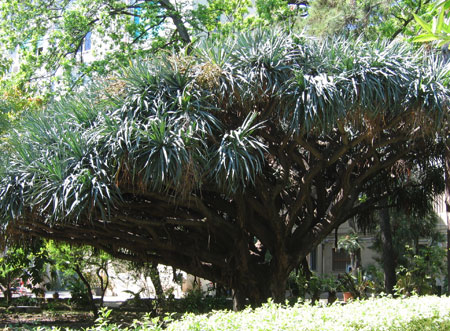
|
Canary
Island Dragon Tree, Dragon
Tree Dracaena
draco
This is an extremely appealing tree providing deep
shade beneath its umbrella of foliage. I've seen
very few of them, but each one seemed to have an enchantment.
Benefits: This
extremely slow growing tree is said to have medicinal value.
From: Canary Islands and Morocco.
Photographed: In the Palermo Botanical Garden in Sicily, Italy.
Planting and Care: I read two very different versions of caring
for this tree and I'll give you both, though I think the latter is more likely
to give you the tree you'll be looking forward to.
1.
This
tree
will
do
fine
in
a
bright
semi shady area of the garden. Keep in mind it will eventually be a reasonably
short,
less
than 40 feet tall, and
very
wide
tree
so give it some space in anticipation.
2. This tree will thrive in full sun all year round. It prefers a rocky,
sandy soil with excellent drainage and little in the way of organic material.
Think of a hot dry beach area and that's the ideal.
Text and Photographs ©GreenGardeningCookingCuring.com
2012/2018
|
|
| |

|
Dwarf
Bouquet, Calypso Queen Dracaena deremensis
Janet Craig Compacta
Every
time I see this plant I immediately think what an incredibly
hardy Easter lily. That maybe goes to show how hard it is for
me to identify plants, but maybe you'll have the same reaction.
Benefits: One of the best houseplants tested for removing
trichloroethylene.
From: South East Africa
Photographed: In
the Botanical Garden at the Hotel Atitlan on Lake Atitlan in
Guatemala.
Planting and Care: This is another slow growing
member of the family of dracaenas, but like most members it likes
bright
light, rather than sun, and moist soil to grow well.
Text & Photograph
©KO 2010 and ©GreenGardeningCookingCuring.com
2018
|
|
Striped
Dracaena Dracaena Deremensis 'Gold Star'
Benefits: Like other plants in this family, this one may help you clean
the air
of contaminates in your home or office
From: Western tropical Africa rainforest
Photographed: In the Botanical Garden at the Hotel Atitlan
on
Lake
Atitlan
in Guatemala.
Planting and Care: Bright light or dappled sun
and damp, not wet, soil will keep this dracaena growing happily
to
reach
its
normal height of between six and ten feet, though it will take
its time getting there.
Warning: This plant is poisonous for pets.
Text & Photographs
©KO 2010 and ©GreenGardeningCooking.com 2018 |
|
| |
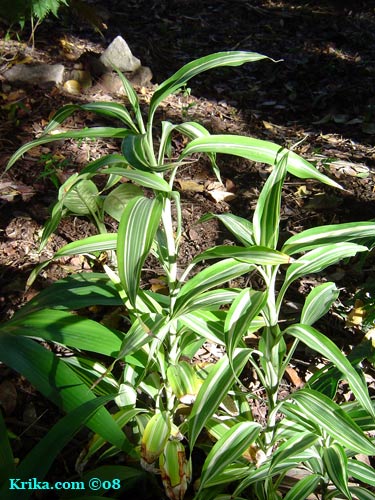
|
**Lucky
Bamboo, Lucky Lily, Ribbon Dracaena, Ribbon Plant, Belgian
Evergreen, Chinese Water Bamboo, Friendship Bamboo, Water
Bamboo Dracaena sanderiana
This is the poor plant that had the terrible karma to be introduced to the commercial
market as a "lucky bamboo" as part of the feng shui craze. It finds
itself growing in a twisted glass bottle and I can't imagine how that would feel.
Can you?
Benefits: Someone got the feng shui craze going
for this poor plant and no doubt they have materially benefited.
From: Tropical western Africa and now widely
grown in gardens throughout the Caribbean
Photographed: In our shady terrace garden at our
former home in Montserrat.
Planting and Care: This is an easy to care for
plant which probably was what sealed its fate with the twisted
glass tubes. From having one for a few years I think a bright semi
shady spot in a garden that receives routine rainfall or watering
would suit it perfectly.
Text
and Photograph ©Krika.com 2008 and GreenGardeningCookingCuring.com
2018 |
|
| |
Song
of India, Pleomele, Reflexed Dracaena Dracaena
reflexa
Benefits: This was and probably still
is NASA’s
best air purifying plant.
From: Madagascar, Mozambique, Mauritius and other
nearby islands of the Indian Ocean
Photographed: In the Palermo Botanical Garden in Sicily, Italy.
Planting and Care: Like other members of this family the Song
of India lives just fine in an apartment or home. Put it in a window with bright
light and water it when the soil feels dry to the touch. It
is
not
frost
tolerant
so
if you are
going to plant it outside it should be warm all year long. Give it dappled sunshine
and water when dry and humid air and it will do just fine.
Warning: This plant is poisonous for pets.
Text & Photograph ©GreenGardeningCooking.com 2018 |
|
|
|
**Dragon
Tree -- See Dracaena
above
|
| **Drunken
Sailor See
The "R" Page -- RANGOON CREEPER |
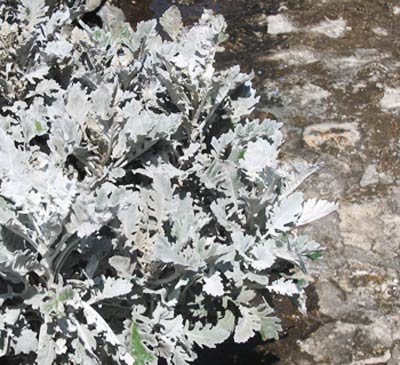
|
**Dusty
Miller, Silver Ragwort Senecio cineraria
I regret to admit that I deemed this perennial plant unattractive
from my very early years as an adult with a beautiful already
established garden to manage. Along with all of the exuberantly
beautiful plants and shrubs, I had dusty miller to look at and
tend. In my opinion, if you are already depressed and looking
for plant company, you've found a friend in Dusty Miller.
Benefits: In Dusty Miller's favor, it is a
medicinal plant with proven therapeutic value in the treatment
of cataract and
corneal
opacity. Please see the warning of toxicity below.
From: Central America
Photographed: In the Botanical Garden at the
Hotel Atitlan on Lake Atitlan in Guatemala.
Planting and Care: Dusty Miller is a perennial.
It likes full sun and is not at all fussy about its soil base.
Water it
regularly
until it is settled in and then pretty much let it be. It is
very hardy.
Warning: Dusty Miller is poisonous
Text & Photograph ©KO
2010 and ©GreenGardeningCookingCuring.com 2018 |
|
| |
Dutchman's
Pipe, Giant Pelican Flower Aristolochia brazillensis,
Aristolochia grandiflora and Aristolochia gigantea
This very strange plant is a seemingly normal, almost delicate vine, which produces
the almost creepy, papery, foot long "flowers" shown below on the right.
This is the variety that produces the largest flowers and shown on the left and
right is a variety with smaller though no less
strange
flowers.
From: The southeastern US
Photographed: In the Botanical Garden at the Hotel Atitlan on Lake Atitlan
in Guatemala and in the Winter Garden in Auckland, New Zealand.
Planting and Care: This is an easy plant to
get off the ground and it is a perennial so it is worth paying
a little attention in the beginning. In warm climates it prefers
a semi shady location, but any decent soil will do as long as
it gets some routine rainfall or watering. What it does need
is support so plan to give it a trellis or something similar
to grow on.
Text & Photograph
©KO 2010 and GreenGardeningCookingCuring.com 2013/2018 |
|
| |
|
|
| |
| **Dwarf
Cone Ginger See
the "G" Page GINGER -- Red Button Ginger |
Dwarf
Mallow, Sleepy Hibiscus, Turk's Cap, Firecracker Hibiscus Malvaviscus
arboreus drummondii
This is a striking shrub because of how its bright red flowers set
off the green of its lush foliage. The flowers aren't extraordinary,
but the overall effect of the plant certainly is. It makes a nice
size shrub growing to be as much as 10 feet tall.
Benefits: This plant will attract both butterflies and hummingbirds.
From: South America, Peru and/or Central America
Photographed:
Planting and Care: Dwarf mallows like
to be in either full sun or bright semi-shade. They don't like heavy
winds
and so are ideal plantings
against a wall or building.
Text ©KO
2011 and ©GreenGardeningCookingCuring.com 2018 |
**Dwarf
Poinciana See
The "P" Page -- PRIDE OF BARBADOS
|
| Dwarf
Tibouchina See
the "T" Page -- TRAILING TIBOUCHINA |
 Mexican
Daisy, Erigeron,
Profusion Santa Barbara Daisy, Profusion Fleabane Erigeron
Karvinskianus Profusion
Mexican
Daisy, Erigeron,
Profusion Santa Barbara Daisy, Profusion Fleabane Erigeron
Karvinskianus Profusion 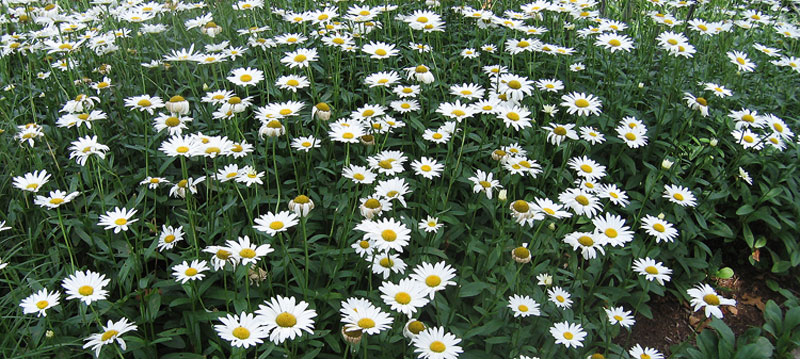
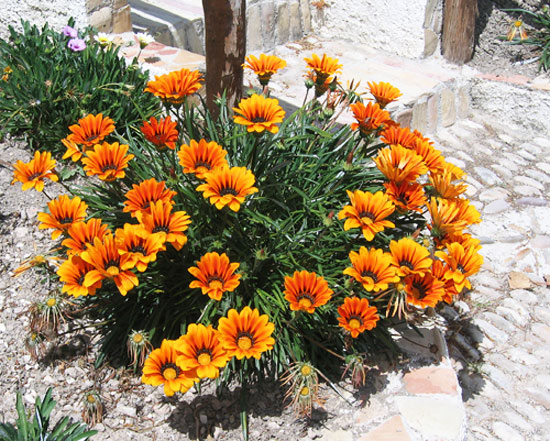
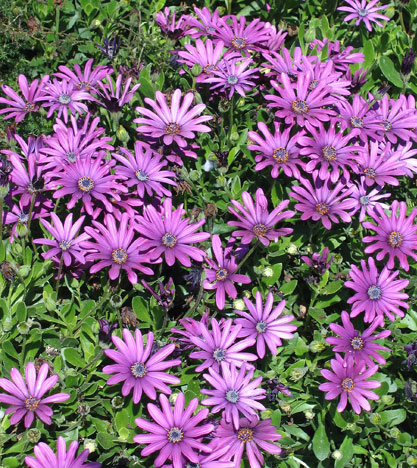
 Dalmatian
Chrysanthemum Chrysanthemum cinerariaefolium
Dalmatian
Chrysanthemum Chrysanthemum cinerariaefolium

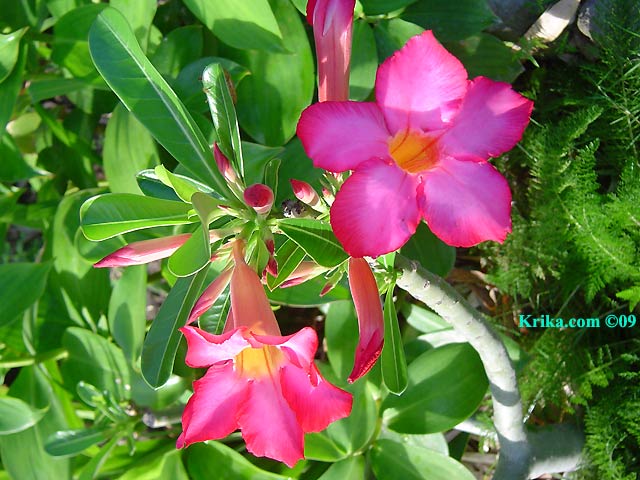
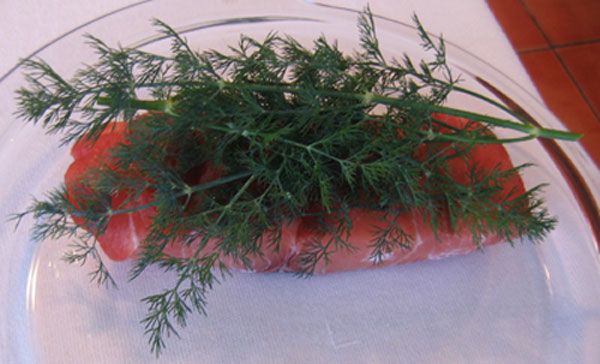
 Doung
Tree, Chinese Date, Jujube, Indian Plum Ziziphus mauritonia jujube
Doung
Tree, Chinese Date, Jujube, Indian Plum Ziziphus mauritonia jujube Corn
plant Dracaena
fragrans
Corn
plant Dracaena
fragrans